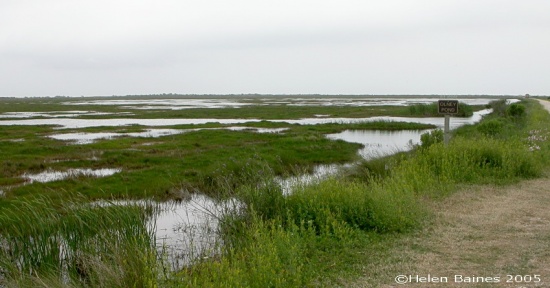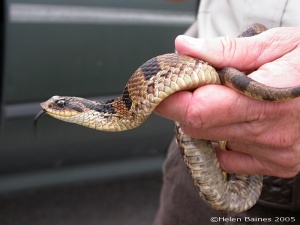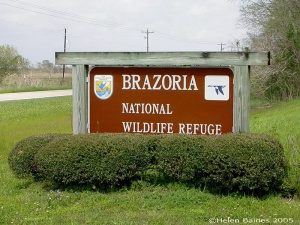Overview
Brazoria National Wildlife Refuge, along with Big Boggy and San Bernard National Wildlife Refuges, is part of an important series of coastal wetlands, on the Central Flyway migratory route, with over 300 species of birds. It is 43,000 acres in size and located south of Houston, in Brazoria County, on the Upper Texas Coast.
It is part of the Great Texas Coastal Birding Trail - site no. UTC 108.
In April, the Annual Migration Celebration is held at San Bernard NWR. More information

Spotting scope highly recommended for viewing Rogers Pond from the observation deck, Oct. 2006
Birds
The official bird list is currently being updated (March 2015)
Notable Species
Best birding is in the winter months, when there are thousands of geese, up to 24 species of ducks, shorebirds such as dowitchers, yellowlegs and sandpipers, Sandhill Cranes and 13 species of sparrows. Raptors such as White-tailed Kite, Northern Harrier, Swainson's Hawk and Red-tailed Hawk.
Rarities
Trumpeter Swan in February, 2002. Black-tailed Godwit, a Eurasian species in June 2012.
Check-list
Birds you can see here include:
Black-bellied Whistling-Duck, Fulvous Whistling-Duck,Greater White-fronted Goose, Snow Goose, Ross's Goose, Canada Goose, Wood Duck, Gadwall, American Wigeon, Mallard, Mottled Duck, Blue-winged Teal, Cinnamon Teal, Northern Shoveler, Northern Pintail, Green-winged Teal, Canvasback, Redhead, Ring-necked Duck, Lesser Scaup, Bufflehead, Common Goldeneye, Hooded Merganser, Red-breasted Merganser, Ruddy Duck, Northern Bobwhite, Common Loon, Pied-billed Grebe, Eared Grebe, American White Pelican, Brown Pelican, Neotropic Cormorant, Double-crested Cormorant, Anhinga, Magnificent Frigatebird, American Bittern, Least Bittern, Great Blue Heron, Great Egret, Snowy Egret, Little Blue Heron, Tricolored Heron, Reddish Egret, Western Cattle Egret, Green Heron, Black-crowned Night-Heron, Yellow-crowned Night-Heron, White Ibis, White-faced Ibis, Roseate Spoonbill, Wood Stork, Black Vulture, Turkey Vulture, Osprey, Swallow-tailed Kite, White-tailed Kite, Mississippi Kite, Bald Eagle, Northern Harrier, Sharp-shinned Hawk, Cooper's Hawk, Red-shouldered Hawk, Broad-winged Hawk, Swainson's Hawk, White-tailed Hawk, Red-tailed Hawk, Crested Caracara, American Kestrel, Merlin, Peregrine Falcon, Yellow Rail, Black Rail, Clapper Rail, King Rail, Virginia Rail, Sora, Purple Gallinule, Common Gallinule, American Coot, Sandhill Crane, Black-bellied Plover, American Golden Plover, Snowy Plover, Wilson's Plover, Semipalmated Plover, Piping Plover, Killdeer, American Oystercatcher, Black-necked Stilt, American Avocet, Spotted Sandpiper, Solitary Sandpiper, Greater Yellowlegs, Willet, Lesser Yellowlegs, Upland Sandpiper, Whimbrel, Long-billed Curlew, Hudsonian Godwit, Marbled Godwit, Ruddy Turnstone, Red Knot, Sanderling, Semipalmated Sandpiper, Western Sandpiper, Least Sandpiper, White-rumped Sandpiper, Baird's Sandpiper, Pectoral Sandpiper, Dunlin, Stilt Sandpiper, Buff-breasted Sandpiper, Short-billed Dowitcher, Long-billed Dowitcher, American Woodcock, Wilson's Snipe, Wilson's Phalarope, Laughing Gull, Franklin's Gull, Bonaparte's Gull, Ring-billed Gull, American Herring Gull, Sooty Tern, Least Tern, Gull-billed Tern, Caspian Tern, Black Tern, Common Tern, Forster's Tern, Royal Tern, Sandwich Tern, Black Skimmer, Rock Dove, White-winged Dove, Mourning Dove, Common Ground Dove, Yellow-billed Cuckoo, American Barn Owl, Eastern Screech Owl, Great Horned Owl, Barred Owl, Common Nighthawk, Chimney Swift, Ruby-throated Hummingbird, Belted Kingfisher, Red-bellied Woodpecker, Yellow-bellied Sapsucker, Northern Flicker, Pileated Woodpecker, Olive-sided Flycatcher, Eastern Wood Pewee, Yellow-bellied Flycatcher, Acadian Flycatcher, Alder Flycatcher, Willow Flycatcher, Least Flycatcher, Eastern Phoebe, Vermilion Flycatcher, Ash-throated Flycatcher, Great Crested Flycatcher, Eastern Kingbird, Scissor-tailed Flycatcher, Loggerhead Shrike, White-eyed Vireo, Yellow-throated Vireo, Blue-headed Vireo, Warbling Vireo, Philadelphia Vireo, Red-eyed Vireo, Blue Jay, American Crow, Horned Lark, Northern Rough-winged Swallow, Purple Martin, Tree Swallow, Bank Swallow, Barn Swallow, Cliff Swallow, Cave Swallow, Carolina Chickadee, Tufted Titmouse, Carolina Wren, House Wren, Sedge Wren, Marsh Wren, Golden-crowned Kinglet, Ruby-crowned Kinglet, Blue-gray Gnatcatcher, Eastern Bluebird, Hermit Thrush, American Robin, Gray Catbird, Northern Mockingbird, Brown Thrasher, European Starling, American Pipit, Sprague's Pipit, Cedar Waxwing, Blue-winged Warbler, Golden-winged Warbler, Tennessee Warbler, Orange-crowned Warbler, Nashville Warbler, Yellow Warbler, Chestnut-sided Warbler, Magnolia Warbler, Yellow-rumped Warbler, Black-throated Green Warbler, Blackburnian Warbler, Yellow-throated Warbler, Palm Warbler, Bay-breasted Warbler, Blackpoll Warbler, Black-and-white Warbler, American Redstart, Worm-eating Warbler, Ovenbird, Northern Waterthrush, Louisiana Waterthrush, Kentucky Warbler, Common Yellowthroat, Wilson's Warbler, Canada Warbler, Summer Tanager, Scarlet Tanager, Eastern Towhee, Field Sparrow, Vesper Sparrow, Lark Sparrow, Savannah Sparrow, Grasshopper Sparrow, Le Conte's Sparrow, Nelson's Sparrow, Seaside Sparrow, Song Sparrow, Lincoln's Sparrow, Swamp Sparrow, White-throated Sparrow, White-crowned Sparrow, Northern Cardinal, Blue Grosbeak, Indigo Bunting, Painted Bunting, Dickcissel, Red-winged Blackbird, Eastern Meadowlark, Brewer's Blackbird, Common Grackle, Boat-tailed Grackle, Great-tailed Grackle, Brown-headed Cowbird, Orchard Oriole, Baltimore Oriole, American Goldfinch, House Sparrow
Other Wildlife
American Alligator, a variety of snakes, turtles, frogs and lizards, Fox Squirrel, Nine-banded Armadillo, Raccoon, Nutria, White-tailed Deer, Bobcat and Coyote.
Site Information
History and Use
Before the European settlers arrived in Texas, the Karankawa Indians lived on this area's plentiful fish and wildlife. By the early 1800's, sugar cane and cotton were cultivated, first by the Spanish, then the Mexicans. Then in more recent times, ranchers grazed cattle on the land that eventually became the refuge.
Areas of Interest
- Big Slough Boardwalk and Trail (0.6 miles)
- Big Slough Auto Tour around Olney Pond (7.5 miles)
- Middle Bayou Trail (2 miles)
Access and Facilities
- Open daily from dawn to dusk.
- Entrance is free of charge.
- Discovery Center, where staff and volunteers host hands-on environmental programs.
- Fishing is possible in 3 public fishing area.
- Maps, brochures and interpretive displays in the Information Pavilion.
- Restrooms (toilets) and drinking fountains.
Contact Details
Brazoria NWR
1212 North Velasco, Suite 200
Angelton, TX 77515
Phone: 979-233-5338
External Links
- USFWS official website for Brazoria NWR
- Map of Brazoria NWR
- Friends of Brazoria NWR
- Great Texas Coastal Birding Trail - Brazoria Loop
Content and images posted by HelenB






